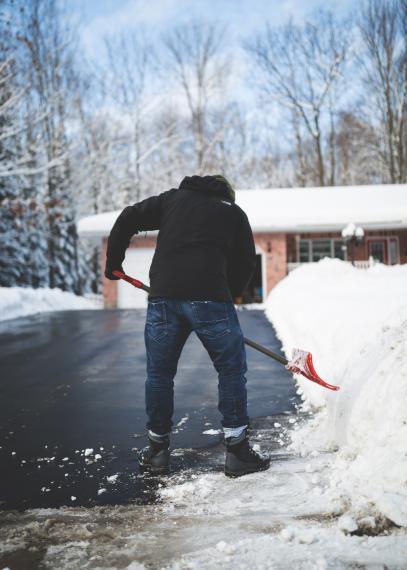Preventing Common Injuries during these Winter Activities

When the snow hits this winter, there are many fun and enjoyable activities to do in the snow and on the ice. Many Canadians look forward to traveling up the mountains to ski or snowboard. Others find delight in sledding down snow hills, or having a good ol’ snowball fight. For those who prefer lower-impact activities, they may take some time to go snowshoeing and ice-skating. And believe it or not, shovelling snow is also considered a good body workout.
However, as fluffy and soft as snow may seem, people can easily injure themselves when participating in these winter activities. So, make sure that you know how to prevent these common winter injuries and take safety precautions before carrying out your long-awaited fun.
Precaution tips for all activities1:
- It is always a good idea to warm up your muscles thoroughly and have them stretched appropriately before engaging in activity. Cold muscles, tendons, and ligaments are vulnerable to injury. Examples include squats for your legs, trunk rotations for your lower back, and arm circles for your shoulders.
- Wear the appropriate protective gear, including helmets, gloves, warm gear, and padding.
Skiing/ Snowboarding2
1. Knee sprains: Knee injuries are very common, particularly injuries to the anterior cruciate ligament (ACL), which is one of the short ligaments that holds the middle of the knee together. The ACL can be easily damaged by a sudden twist while the foot is still planted on the ground. Here are some ways to help prevent damage to the ACL:
- Don’t fully straighten your legs when you fall. Your knees should remain flexed until you have stopped sliding. However, try to resist the urge to throw out your hands to stop yourself, because this can create a sharp angle with your legs that will put pressure on your knees.
- Don’t jump unless you know where and how to land. Learn to land safely on both skis, with your weight forward and knees flexed. Start with simple jumps and gradually advance to more difficult jumps.
- Simple ski techniques to stick by: hands and weight forward, legs parallel, and hips, knees, and ankles flexing equally.
2. Shoulder dislocations: Skiers frequently put their arms out to break a fall, and falling onto an outstretched hand causes pressure to build and shoot up the arm. The best way to avoid shoulder injuries in this situation, other than using protective gear before you ski, is to fall the right way.
- Falling forward: Use your forearms to break your fall instead of reaching your palms out in front.
- Falling Backwards: Don’t stick your arms out behind you. Try turning your body slightly and keeping your arms in a curled position, with your fist at the side of your face between it and the ground.
3. Skier’s thumb: Skier’s thumb is an injury to the ulnar collateral ligament (UCL), which is a ligament that runs between the two bones on the inside of your thumb and holds them together. This injury can occur when skiers fall on an outstretched hand while holding their ski pole, causing the thumb to bend backwards or too far out to the side. Here are some ways to protect yourself from UCL injury:
- Let go of your ski poles when you fall
- Choose ski poles that have finger groove grips instead of wrist straps so your ski poles are free to fall away from your hand when you let go during a fall.
Ice-skating3
About half of all ice-skating injuries are caused by overuse and repetitive stress, and are preventable. Here are some of the most common ice skating injuries:
1. Knee pain: Often, landing on your knee when you fall has no worse consequences than a bruise. But in some rare cases, the bulk of abuse that your knees will absorb can cause a misalignment of the kneecap. This will lead to chronic knee pain and the knee cartilage may eventually wear down. Kneepads can help reduce the risk of knee injury when you take a fall on the ice.
2. Weak ankles: Ankle sprains are one of the more common sports injures. The weight of your entire body is supported by your ankles, which makes them very likely targets for pain and injuries. A good way to help prevent ankle injury is to make sure that your skates are a good fit. Ensure the laces are tight enough so that your foot is snug and secure in the skates.
Snow Shovelling4
*Note: Snow shovelling can be a risky activity/exercise. This activity can be dangerous for people who are not used to physical activity, have pre-existing injuries or conditions such as a history of heart disease and/or high blood pressure, or those who smoke.
For those who are in good physical condition, it is important to remember proper form:
Start with the easiest/ lightest shovelling and move more snow as you’ve warmed up.
-
Do not load the shovel with too much weight
-
Incorporate your whole body while shovelling.
-
Switch your lead hand and foot at even time intervals
-
Try to make your shovelling load as consistent as possible.
-
Engage (tighten) your abs as you shovel
-
Keep your hips and shoulders square in front of the shovel
-
Move your whole body (pelvis included) to toss the snow aside
References
1. https://orthoinfo.aaos.org/en/staying-healthy/winter-sports-injury-prevention
2.www.stopsportsinjuries.org/STOP/Prevent_Injuries/Skiing_and_Snowboarding_Injury_Prevention.aspx
3.http://www.stopsportsinjuries.org/STOP/STOP/Prevent_Injuries/Figure_Skating_Injury_Prevention.aspxhttps://www.thoughtco.com/skaters-feet-or-ankles-hurt-1963741
4. https://ottawamagazine.com/people-and-places/ask-the-experts-is-shovelling-snow-a-good-form-of-exercise/
Learn more from the Health & Performance Centre at U of G: https://wellness.uoguelph.ca/hpc/.

